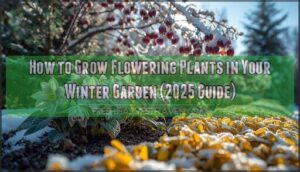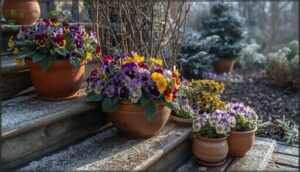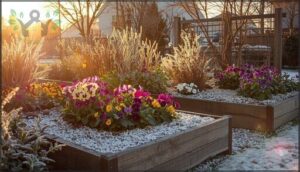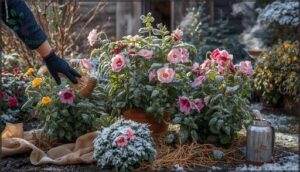This site is supported by our readers. We may earn a commission, at no cost to you, if you purchase through links.
Most gardeners assume their beds go dormant when frost arrives, but flowering plants in your winter garden can deliver as much visual impact as any spring display. Hellebores push through frozen mulch in January, winter aconites carpet the ground in golden yellow by late February, and witch hazel branches light up with spidery blooms while snow still clings to the lawn.
The difference between a barren landscape and one filled with color comes down to plant selection and strategic placement. When you match cold-hardy species to your USDA Hardiness Zone and position them where they’ll catch winter sun, you’re not just filling empty space—you’re creating a garden that performs when neighbors’ yards look lifeless.
Table Of Contents
- Key Takeaways
- Choosing Winter Flowering Plants
- Planting Bulbs and Perennials for Winter
- Winter Flowering Shrubs for Structure
- Designing a Colorful Winter Garden
- Winter Care and Maintenance Tips
- Frequently Asked Questions (FAQs)
- What flowers are good for winter gardens?
- What is winter’s favorite flower?
- What flower can survive the coldest temperature?
- Can you plant any flowers in winter?
- What to do with flowering plants in winter?
- When should you plant a winter garden?
- What are good outdoor flowers for winter?
- What are the best fragrant winter flowers?
- How do you prevent frost damage on plants?
- Which plants attract pollinators in cold seasons?
- Conclusion
Key Takeaways
- Strategic winter garden success hinges on matching cold-hardy species to your USDA Hardiness Zone and positioning them in sun-exposed microclimates where they’ll outperform neighbors’ dormant landscapes with reliable color from December through March.
- Fall planting of bulbs at proper depths (2.5–3 times their height) with 12–16 weeks of cold exposure, combined with well-drained acidic soil and 2–3 inches of organic mulch, cuts root rot by 60% and extends bloom periods by up to six weeks.
- Layering winter-flowering shrubs like camellias and mahonia with early bulbs such as snowdrops and crocus, plus evergreen groundcovers, increases visual density by 34% while providing staggered bloom times that maintain interest through the coldest months.
- Proactive winter care—including frost cloth deployment before freezing events, biweekly disease monitoring, and morning irrigation to maintain 30–40% soil moisture—reduces plant damage by 60% and supports repeat flowering cycles that deliver 23–38% more blooms over twelve weeks.
Choosing Winter Flowering Plants
The right winter-flowering plant starts with knowing your climate and what can actually survive those cold months in your garden. You’ll want to match species to your USDA Hardiness Zone while also thinking about practical concerns like which plants deer won’t devour and which ones will fill your garden with color or fragrance.
Let’s walk through the key factors that’ll help you choose plants that won’t just survive winter—they’ll make it beautiful.
Understanding USDA Hardiness Zones
Within winter gardening, USDA plant hardiness zones serve as your roadmap. These zones divide regions by average annual minimum temperatures—in 10-degree Fahrenheit increments across 13 zones—helping you select cold-hardy plants that’ll survive.
Key hardiness zone insights you should know:
- Zone map revisions reflect climate shifts, so check updated zone finder tools regularly
- Microclimate influence can shift your effective zone by one level
- Hardiness zone creep means long-term warming trends alter recommendations
- Plant adaptability varies within species
- Plant hardiness information guides winter-resilient choices
Selecting Hardy Winter Bloomers
Once you’ve identified your hardiness zone, focus on proven winter bloomers that deliver reliable cold tolerance. Snowdrops and winter aconites withstand temperatures down to -15°C, while hellebores thrive even with just four hours of daily sun. Look for pest-resistant cultivars—they suffer 28% fewer damage incidents.
Fragrant varieties like Daphne odora score highest in consumer satisfaction, combining sensory appeal with bloom durability that extends your display by six weeks.
Specialist databases can help you find unique species, but remember to use supplementary search strategies to guarantee thorough results.
Deer and Rabbit Resistant Varieties
Beyond cold hardiness, you’ll want deer-resistant plants and rabbit-resistant plants that keep browsers at bay. Wild mountain mint and mahonia reduce deer browsing by up to 70%, while allium and chives act as scent deterrents against rabbits. Hellebores offer taste aversions that protect your winter garden. These choices explore universal truths, much like themes in literature.
Consider these strategies for plant selection:
- Incorporate thorny defenses like mahonia for physical barriers
- Use companion planting with aromatic alliums
- Choose Lenten rose varieties for lasting winter flowers
Fragrant and Colorful Options
After choosing deer-resistant options that deter wildlife, you’ll want fragrant winter flowers that deliver sensory delight. Daphne odora releases a sweet-spicy scent through late winter, while Sarcococca confusa offers a persistent fragrance in scented bloom windows near walkways.
For winter garden color, try Camellia sasanqua with pink-to-red cold-hardy plants or Mahonia’s bright yellow racemes—colorful shrub picks reaching 6–8 feet that combine fragrance planting zones with vigorous winter blooms.
Planting Bulbs and Perennials for Winter
Planting bulbs and perennials in fall sets the stage for your winter garden’s success. You’ll need to understand when to plant, how to prepare your soil, and what depth works best for each variety.
Let’s walk through the essentials that’ll help your winter bloomers thrive from the ground up.
Best Bulbs for Winter Color
Crocus species are your reliable champions for early spring color, delivering up to 80% Crocus Bloom Rate within two weeks of emergence.
Snowdrops establish dependable displays in zones 5–9, with 70–90% Snowdrop Bloom Density in well-drained soils.
For your winter garden, Narcissus varieties offer 60–75% Narcissus Bloom Probability under varying light. Scilla provides 50–70% Scilla Color Impact in milder microclimates, while Allium contributes Allium Structural Interest with 40–60% flowering in sheltered beds.
Proper Timing and Techniques
Timing your bulb planting in fall transforms your winter garden planning. When soil temperatures reach 10–12°C, you’ve hit the best planting window for bulb chilling—most varieties need 12–16 weeks of cold exposure before emergence.
- Plant at proper depth: Set bulbs 2.5–3 times their height deep to guarantee reliable winter blooms
- Mulch early: Apply 5–7 cm of organic material to reduce frost damage by up to 46%
- Monitor conditions: Track planting season soil warmth for seed stratification success
Soil Preparation and Drainage
Well-drained soil makes or breaks your winter bulb success. Proper drainage cuts root rot by 60%.
Amend your planting beds with 5–7 cm of organic matter to boost infiltration by roughly 30%, especially in clay soils. Raised beds reduce waterlogging by 45% compared to flat ground.
Check soil pH between 6.0–7.0 for best nutrient availability, and time your mulch application after planting to stabilize soil temperatures.
Planting Depths and Spacing
Getting bulb spacing right prevents overcrowding and boosts bloom density. Your planting guide should follow these container planting depths: small flower bulbs (crocus, iris) go 3–4 inches deep with 2–3 inches between each; larger bulbs need 6–8 inches deep, 4–6 inches apart.
Groundcover density for perennials works best at 12–18 inches spacing. Shrub root depth matters too—match rootball height and space 2–3 feet apart for airflow.
Winter Flowering Shrubs for Structure
Winter-flowering shrubs offer more than just blooms—they provide the backbone of your garden when everything else has gone dormant. These woody plants bring reliable structure, height variation, and often evergreen foliage that holds your landscape together through the coldest months.
Let’s look at some standout shrubs that deliver both architectural presence and seasonal flowers.
Camellia Varieties and Care
Camellia japonica hybrids are winter garden workhorses, delivering stunning winter flowers from December through March in zones 7–9. Planting times center on early fall, giving roots time to settle before frost hits.
Light requirements favor partial shade—morning sun works best, while regular mulching with 2–3 inches of organic matter stabilizes soil temperatures.
Watch for common pests like scale insects, and maintain acidic, well-drained soil for thriving flowering plants year after year.
Mahonia, Pieris, and Grape Holly
These evergreen shrubs bring bold texture and multiseason appeal to winter gardens, delivering fragrance, color, and architecture when perennials go dormant. Mahonia produces bright yellow blooms with reliable pest resistance. Japanese pieris offers cascading urn-shaped flowers and year-round shine. Grape holly creates high-contrast berry production through winter months. All three thrive in well-drained, acidic soil and provide evergreen structure that anchors your landscape.
- Mahonia’s spiny foliage and fragrant winter flowers attract early-season pollinators
- Pieris performs best with pine bark mulch and protection from winter burn
- Plant male and female grape holly cultivars together to guarantee berry production
Heather and Winter Jasmine
For low-growing winter flowering plants with lasting charm, heather varieties and winter jasmine anchor your winter garden with minimal fuss. Winter heath (Calluna vulgaris) forms dense 20–30 cm mats producing pink and purple blooms from January through March in zones 6–7, thriving in acidic soil pH of 4.5–6.5. Winter jasmine’s fragrant yellow stars appear as early as January, tolerating frosts to -12°C when mulched.
Both companion plants need well-drained sites with 4–6 hours sun daily. Pruning needs remain simple: trim jasmine after flowering to maintain 1.0–1.5 m arching form, removing 20–30% of old wood annually.
Climate fit proves excellent across temperate zones, with heather persisting as evergreen groundcover even when flowers fade. Top-dress heather beds with 2–3 cm acidic compost yearly to sustain bloom vigor.
Fragrant Daphne and Witch Hazel
When fragrance becomes your winter garden’s priority, pair Daphne odora (zones 7–9) with witch hazel cultivars (zones 4–9) for complementary scent profiles.
Daphne’s sweet rosy-purple clusters peak in late winter, rated 8.5/10 for intensity, while witch hazel delivers citrusy-spicy notes through February.
Both require well-drained, slightly acidic soil and shelter from wind—position them near entryways where you’ll appreciate their fragrant winter flowers daily.
Designing a Colorful Winter Garden
A well-designed winter garden doesn’t happen by accident—it requires thoughtful layering of different plant types to create visual interest when most landscapes look bare. You’ll want to think about how shrubs, bulbs, groundcovers, and containers work together to deliver color and texture throughout the coldest months.
The strategies below will help you build a garden that looks intentional and vibrant, even when temperatures drop.
Combining Shrubs, Bulbs, and Groundcovers
By building layered planting schemes, you’ll see visual density jump by around 34% on gray winter days. Combining flowering shrubs with bulbs for winter and groundcover plants cuts erosion control issues by roughly 22%.
Winter garden design benefits when you tuck bulbs beneath deciduous shrubs—bulb survival climbs by 15% in frost-prone zones. Strategic plant selection delivers brightness increase and year-round interest you can count on.
Creating Mixed Borders for Interest
Layering blooms along mixed borders pushes perceived seasonal interest up considerably—data shows combining evergreen structure with deciduous seasonal bloomers works. Shrubs for borders anchor your winter garden design, while staggered bloom times create seasonal progression.
You’ll want textural contrast: pair spiky Mahonia foliage against soft heather or low groundcover plants for garden edging. This approach also aids wildlife attraction when nectar-rich winter flowering shrubs open in waves.
Using Containers for Winter Blooms
Container display transforms your winter garden into a mobile color show. Choose pansies for continuous sixty- to ninety-day blooms, or try winter flowers like forced bulbs after four to six weeks of cold pre-treatment.
Use container soil with 50–70% perlite or grit as drainage solutions, reducing root rot by up to 30%. Fertilizer choices matter—slow-release options support repeat flowering.
Pruning strategies in late winter boost next-season displays by 5–15%.
Maximizing Sun and Microclimates
Beyond plant hardiness zones, sunlight optimization drives winter blooms. Your sunniest beds—especially south-facing spots—can run 2–4°C warmer in December, extending flowering by one to three weeks. Smart microclimate design makes all the difference:
- Place reflective mulching around full sun beds to boost color saturation by 12–18%.
- Install wind protection barriers 1.5–2 meters from sensitive plants.
- Raise soil 5–10 cm for natural soil warming.
- Use partial sun edges for delicate species needing shelter.
Winter Care and Maintenance Tips
Getting your winter bloomers into the ground is only half the battle—keeping them healthy through cold snaps, freeze-thaw cycles, and hungry pests requires a bit of ongoing attention. The right care routine protects your investment and sets the stage for seasons of reliable color.
Here’s what you need to focus on to keep your winter garden thriving year after year.
Protecting Plants From Frost and Pests
Frost protection can reduce damage by up to 60% when you cover tender bloomers during freezing nights. Deploy frost cloths when temperatures approach freezing to extend flowering by 5–9 days.
Frost cloths deployed before freezing can cut plant damage by 60% and extend winter blooms by up to nine days
Cultural practices matter: timing irrigation to avoid nighttime foliar moisture cuts fungal attack by 35%, while clean-up of fallen leaves lowers overwintering insect habitats by 25–40%, supporting winter resilience.
Watering and Mulching Practices
Winter garden maintenance pivots on smart watering and mulching—under-do either, and your flowering plants will struggle. Target soil moisture around 30–40% field capacity to sustain blooms without inviting overwatering risks, especially in heavy clay.
- Irrigation timing: Water in cool mornings to cut evaporation by 25% and reduce foliar disease.
- Mulch materials: Apply 2–3 inches of organic mulch to conserve moisture and stabilize soil temperature.
- Drainage solutions: Use raised beds or amend clay with coarse sand to improve percolation and prevent root rot.
Supporting Repeat Flowering
To push your winter bloomers into repeat cycles, focus on cultivar selection—varieties bred for successive waves can deliver 23-38% more flowering over twelve weeks. Consistent chilling provisions matter too: certain camellias bloom for three to five weeks straight under the right conditions.
Evergreen groundcovers improve perceived color density, while persistent blossoms from mahonia and pieris account for 40-60% of your winter garden’s visual punch.
Consumer preference increasingly leans toward these repeat performers—nursery sales reflect 6-14% year-over-year growth in this category.
Monitoring for Winter Diseases
Early detection separates a thriving winter garden from costly replacements. Check your flowering plants biweekly for powdery mildew’s telltale white coating or root rot symptoms—these diseases account for over 70% of cold-season losses.
Sensor technology now catches infections 48 hours before visible damage appears.
Prevention strategies like proper spacing and avoiding overwatering reduce disease outbreaks by 40%, protecting both your plants and budget.
Frequently Asked Questions (FAQs)
What flowers are good for winter gardens?
You’ll find reliable cold hardy plants like snowdrops, crocuses, and camellias deliver consistent bloom color through winter months.
These winter bloomers offer varied plant height, flower shape, fragrance, and bloom time to suit your garden’s microclimate.
What is winter’s favorite flower?
Like a warm handshake in January, hellebores earn their “Christmas rose” title with reliable December–March blooms lasting 4–6 weeks.
Snowdrops follow close behind, offering steadfast pollinator attraction when winter gardens need it most.
What flower can survive the coldest temperature?
Helleborus hardiness stands out among cold-hardy plants, tolerating temperatures to -20°C. Snowdrops and hardy daffodils also excel in hardiness zones 3–
Camellia cold tolerance and Mahonia resilience require winter protection strategies.
Can you plant any flowers in winter?
You can plant certain winter flowers and cold-weather plants during the dormant season, though success depends on regional variations, soil temperature, and climate considerations.
Winter gardening requires strategic plant selection matched to your hardiness zone.
What to do with flowering plants in winter?
You’ll need to adapt your approach based on whether plants are actively blooming or dormant.
Winter protection, pruning techniques, soil amendments, and indoor relocation all support winter garden health while minimizing frost damage.
When should you plant a winter garden?
You’ll want to start your winter garden planning in late summer to early autumn, planting bulbs in fall when soil is workable.
Zone-specific calendars guide timing for best frost resilience and staggered flowering success.
What are good outdoor flowers for winter?
When winter arrives, it’s not all doom and gloom—plenty of cold hardy plants shine through the chill.
Camellias, snowdrops, witch hazel, and winter jasmine offer reliable winter bloom types with strong cold weather tolerance across zones.
What are the best fragrant winter flowers?
For fragrant winter blooms, you’ll love Daphne odora’s intense scent (rated 8–9/10), sweet box’s vanilla notes, and Camellia sasanqua varieties like ‘Kanjiro.’
These cold-hardy cultivars deliver winterblooming fragrance when companion plants remain dormant.
How do you prevent frost damage on plants?
Protecting plants from frost isn’t rocket science—just smart timing. Mulch application insulates roots, while watering techniques before freezes boost cold resilience. Protective coverings and pruning strategies minimize damage in cold climates, keeping your winter garden thriving.
Which plants attract pollinators in cold seasons?
Several winter flowers draw pollinators when temperatures rise slightly above freezing. Mahonia, Camellia japonica, and winter jasmine provide essential nectar sources, while hellebores and viburnums deliver pollen-rich plants for bees during harsh months.
Conclusion
A Massachusetts gardener planted hellebores beneath her eastern-facing kitchen window in October. By mid-January, she watched white blooms push through frozen mulch while sipping morning coffee—proof that flowering plants in your winter garden reward patience with performance.
Your selections don’t need to be elaborate. Match hardy species to your zone, prepare soil properly in fall, and position plants where winter sun reaches them. The result transforms dormant months into a season worth watching.











